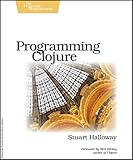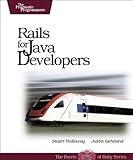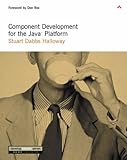Stuart Halloway
President of Cognitect
Stuart Halloway is a founder and President of Cognitect, Inc. (www.cognitect.com). He is a Clojure committer, and a developer of the Datomic database.
Stuart has spoken at a variety of industry events, including StrangeLoop, Clojure/conj, EuroClojure, ClojureWest, SpeakerConf, QCon, GOTO, OSCON, RailsConf, RubyConf, JavaOne, and NFJS.
Stuart has written a number of books and technical articles. Of these, he is most proud of Programming Clojure.
Learn more about Stu's presentations on his wiki.
Presentations

Architectural Briefings are interactive presentations by and for architects on specific technology topics. The purpose is to empower architects to make decisions about the choice and application of tech. Note that you don't have to have “Architect” in your title to participate, this is for anybody who makes architectural decisions.
Developers make decisions all the time, and can never have enough information and support. At Cognitect, we run a weekly Architectural Briefing as a resource for the team. Everybody participates, both attending and speaking. In this talk, we will cover
- a template for Architectural Briefings
- how to develop and present an Architectural Briefing
- how to run an Architectural Briefing program in your organization
We will finish with an example briefing, showing how these ideas come together.

The key to understanding Clojure is ideas, not language constructs.
In this talk, we will approach Clojure via 10 Big Ideas.
Each of these ideas is valuable and useful a la carte, not necessarily
only in a Clojure together. Taken together, they beging to fill in the
picture of why Clojure is changing the way many programmers think
about software development.
- edn
- Persistent Data Structures
- Atomic Success Model
- Seqs
- Protocols
- ClojureScript
- Reducers
- core.logic
- Datalog
- core.async

The key to understanding Clojure web development is ideas, not language constructs. In this talk, we will approach Clojure web development via 7 Big Ideas. Each of these ideas is valuable and useful a la carte, and not necessarily only in Clojure. Taken together, they begin to fill in the picture of why Clojure is changing the way many programmers think about web development.
The key to understanding Clojure web development is ideas, not language constructs. In this talk, we will approach Clojure web development via 7 Big Ideas:
- edn, not json
- core.async, not callbacks
- platform, not language
- data, not objects
- protocols, not interfaces
- libraries, not frameworks
- Ash za durbatulûk!
Each of these ideas is valuable and useful a la carte, and not necessarily only in Clojure. Taken together, they begin to fill in the picture of why Clojure is changing the way many programmers think about web development.

The goal of core.async is to decouple producers and consumers of
information in software, without dictating specific thread or blocking
semantics, and without introducing callback hell. Also, to do all of this
as a library, portable anywhere you can run a dialect of Clojure.
Queues are a powerful tool for decoupling software
programs. Unfortunately, platforms that have powerful queueing
libraries (e.g. Java) may require blocking threads on the ends of the
queue. And the world's biggest platform (JavaScript in the browser)
doesn't even have queues or threads.
core.async builds upon the work done with Communicating Sequential
Processes,
and provides:
- facilities for independent threads of activity, communicating via
queue-like channels - both real threads and shared use of thread
pools (in any combination), as well as ClojureScript on JS engines
In this talk, we will cover the design of core.async, and then move
directly to exploring core.async's capabilities:
- Creating unbuffered and buffered channels
- Threaded put
>!!and take<!! - Using
goblocks to invert control, achieving async without threads - IOC put
>!and take<! - Simultaneously waiting for multiple operations with
alts!andalts!! - Timeouts as “just another kind of channel”
Finally, we will assemble these primitives into substantial working
programs, building toward the Holy Grail of async: substantial UI
application development in the browser, with no callbacks in sight.

Traditional automated testing approches combine input generation, execution, output capture, and validation inside the bodies of single functions. Generative testing approaches gain expressive power by isolating these steps.
With generative testing:
- a generator is a declarative description of possible inputs to a function
- execution is up to your program
- outputs are data, and can be captured for future study
- validators are programs that have access to the generators, the program, and the outputs
There are a number of benefits to this approach:
- once test data generation is separate, it is immediately obvious that such data generation should be statistical, not merely a few hand-picked cases
- validators can be reused in a variety of
- it becomes easier to identify and develop declarative, logic-based validations, rather than imperative ones
- the various phases can be decoupled and run at different times
This talk introduces test data generation and generative testing, using for its examples the data.generators and test.generative libraries developed by the author.
Resources
- test.generative
- data.generators
- chapter 10 of Programming Clojure

The software industry changes rapidly, but you can protect yourself
from these changes by creating code that is complicated enough that
only you can maintain it.
Of course you should not engage in obvious bad practices. The good
news is that you don't have to. You can follow idiomatic industry
practice and stay buzzword compliant with the latest trends, while
quietly spreading complexity throughout systems. Better yet, the
symptoms will show up not in your own code, but in other code that
uses your code, directly or indirectly. You will be a hero as you
lead larger and larger teams burning the midnight oil to keep systems
alive.
Practice these principles, and your code will have an
infectious complexity that guarantees you will always be needed to
maintain it.
- Use OO, and don't forget those setter methods!
- Prefer APIs over data.
- Start with DSLs.
- Always connect (and never enqueue).
- Create abstractions for information.
- Use static typing across subsystem boundaries.
- Put language semantics on the wire.
- Write lots of unit tests.
- Leverage context.
- Update information in place.

Simulation allows a rigorous, scalable, and reproducible approach to testing. The separation of concerns, and the use of a versioned, time-aware database, give simulation great power. This talk will introduce simulation testing, walking through a complete example using Simulant, an open-source simulation library.
Simulation allows a rigorous, scalable, and reproducible approach to testing:
Statistical modeling
Simulation begins with statistical models of the use of your system. This model includes facts such as “we have identified four customer profiles, each with different browsing and purchasing patterns” or “the analytics query for the management report must run every Wednesday afternoon.” Models are versioned and kept in a database.
Activity streams
The statistical models are used to create activity streams. Each agent in the system represents a human user or external process interacting with the system, and has its own timestamped stream of interactions. With a large number of agents, simulations can produce the highly concurrent activity expected in a large production system.
Distributed execution
Agents are scaled across as many machines as are necessary to both handle the simulation load, and give access to the system under test. The simulator coordinates time, playing through the activity streams for all the agents.
Result Capture
Every step of the simulation process, including modeling, activity stream generation, execution, and the code itself, is captured and stored in a database for further analysis. You will typically also capture whatever logs and metrics your system produces.
Validation
Since all phases of a simulation are kept in a database, validation can be performed at any time. This differs markedly from many approaches to testing, which require in-the-moment validation against the live system.
Separation of concerns
The separation of concerns above, and the use of a versioned, time-aware database, gives simulation great power. Imagine that you get a bug report from the field, and you realize that the bug corresponds to a corner case that you failed to consider. With a simulation-based approach, you can write a new validation for the corner case, and run that validation against your past simulation results, without ever running your actual system.
This talk will introduce simulation testing, walking through a complete example using Simulant, an open-source simulation library.
Books
Programming Clojure
by Stuart Halloway and Aaron Bedra
-
If you want to keep up with the significant changes in this important language, you need the second edition of Programming Clojure. Stu and Aaron describe the modifications to the numerics system in Clojure 1.3, explain new Clojure concepts such as Protocols and Datatypes, and teach you how to think in Clojure.
Programming Clojure, 2nd Edition is a significant update to the classic book on the Clojure language. You'll get thorough coverage of all the new features of Clojure 1.3, and enjoy reorganized and rewritten chapters that reflect the significance of new Clojure concepts. Many code examples have been rewritten or replaced, and every page has been reevaluated in the light of Clojure 1.3.
As Aaron and Stu show you how to build an application from scratch, you'll get a rich view into a complete Clojure workflow. And you'll get an invaluable education in thinking in Clojure as you work out solutions to the various parts of a problem.
Clojure is becoming the language of choice for many who are moving to functional programming or dealing with the challenges of concurrency. Clojure offers:
The simplicity of an elegantly designed language
The power of Lisp
The virtues of concurrency and functional style
The reach of the JVM
The speed of hand-written Java code
It's the combination of these features that makes Clojure sparkle. Programming Clojure, 2nd Edition shows you how to think in Clojure, and to take advantage of these combined strengths to build powerful programs quickly.
What You Need:
Oracle JDK 6
A text editor
Programming Clojure (Pragmatic Programmers)
by Stuart Halloway
-
Clojure is a dynamic language for the Java Virtual Machine, with a compelling combination of features:
Clojure is elegant. Clojure's clean, careful design lets you write programs that get right to the essence of a problem, without a lot of clutter and ceremony.
Clojure is Lisp reloaded. Clojure has the power inherent in Lisp, but is not constrained by the history of Lisp.
Clojure is a functional language. Data structures are immutable, and functions tend to be side-effect free. This makes it easier to write correct programs, and to compose large programs from smaller ones.
Clojure is concurrent. Rather than error-prone locking, Clojure provides software transactional memory.
Clojure embraces Java. Calling from Clojure to Java is direct, and goes through no translation layer.
Clojure is fast. Wherever you need it, you can get the exact same performance that you could get from hand-written Java code.
Many other languages offer some of these features, but the combination of them all makes Clojure sparkle. Programming Clojure shows you why these features are so important, and how you can use Clojure to build powerful programs quickly.
Rails for Java Developers
by Stuart Halloway and Justin Gehtland
-
Many Java developers are now looking at Ruby, and the Ruby on Rails web framework. If you are one of them, this book is your guide. Written by experienced developers who love both Java and Ruby, this book will show you, via detailed comparisons and commentary, how to translate your hard-earned Java knowledge and skills into the world of Ruby and Rails.
If you are a Java programmer, you shouldn't have to start at the very beginning! You already have deep experience with the design issues that inspired Rails, and can use this background to quickly learn Ruby and Rails. But Ruby looks a lot different from Java, and some of those differences support powerful abstractions that Java lacks. We'll be your guides to this new, but not strange, territory.
In each chapter, we build a series of parallel examples to demonstrate some facet of web development. Because the Rails examples sit next to Java examples, you can start this book in the middle, or anywhere else you want. You can use the Java version of the code, plus the analysis, to quickly grok what the Rails version is doing. We have carefully cross-referenced and indexed the book to facilitate jumping around as you need to.
Thanks to your background in Java, this one short book can cover a half-dozen books' worth of ideas:
- Programming Ruby
- Building MVC (Model/View/Controller) Applications
- Unit and Functional Testing
- Security
- Project Automation
- Configuration
- Web Services
Component Development for the Java¿ Platform
by Stuart Dabbs Halloway
- Java solves certain complex problems that most languages leave to the operating system. This text shows how to use some of the most exciting and powerful of these parts, with design considerations and programming scenarios, and reveals the subtle yet serious potential pitfalls.




